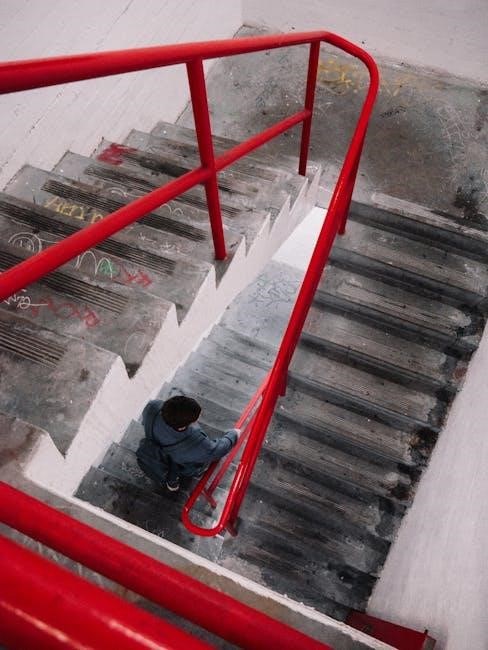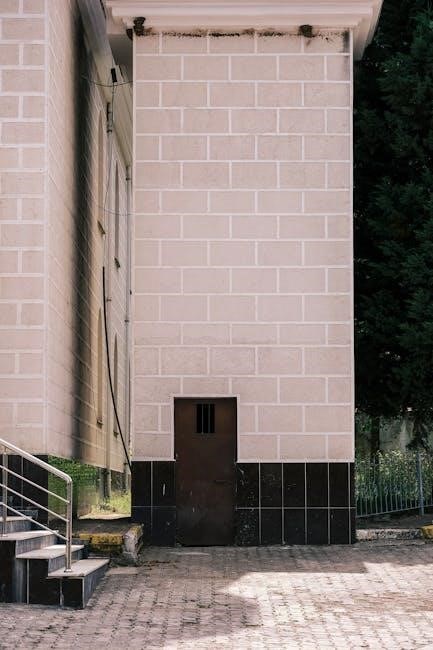Overview of Outdoor Steps Regulations in Australia
The Building Code of Australia governs outdoor steps, ensuring safety and accessibility through standardized design and construction practices. Compliance is essential for public and private spaces.
The Building Code of Australia (BCA) is a national standard that sets the minimum requirements for building and construction projects, including outdoor steps. It ensures compliance with safety, health, and amenity standards. The BCA is part of the National Construction Code and is regularly updated to reflect best practices. It covers structural adequacy, fire resistance, and accessibility, making it a critical reference for designing and constructing outdoor steps in both public and private spaces across Australia.
1.2. Key Standards for Outdoor Stair Construction
The Building Code of Australia (BCA) outlines specific standards for outdoor stair construction, ensuring safety and durability. Key requirements include compliance with AS/NZS 1657:2018, which details riser and tread dimensions, load-bearing capacities, and anti-slip surfaces. Handrails and balustrades must meet height and strength standards to prevent falls. Materials must be durable and weather-resistant, while tread depths and riser heights must adhere to strict ratios for safe ascent and descent. These standards ensure outdoor steps are functional, secure, and accessible for all users.
Structural Requirements for Outdoor Steps
Outdoor steps must meet strict structural requirements, including load-bearing capacities, durability, and compliance with AS/NZS 1657:2018 standards to ensure safety and stability in various environmental conditions.
2.1. Load-Bearing Capacity and Safety Standards
Outdoor steps must comply with AS/NZS 1657:2018, ensuring they can withstand designated loads safely. The Building Code of Australia specifies that steps must support a minimum live load of 2 kPa and a point load of 1.5 kN. Structural integrity is critical, with materials selected for durability and resistance to environmental factors. Regular inspections are required to verify compliance and maintain safety standards. Non-compliance can result in structural failures, posing significant risks to users.

2.2. Compliance with AS/NZS 1657:2018
AS/NZS 1657:2018 outlines specific requirements for stair construction, including tread and riser dimensions, load-bearing capacities, and anti-slip measures. Compliance ensures safety and durability in outdoor steps. Designs must account for environmental factors and user accessibility. Regular inspections are mandated to verify adherence to these standards. Non-compliance can lead to structural failures and legal penalties. Adhering to AS/NZS 1657:2018 is essential for public safety and regulatory approval, ensuring outdoor steps meet Australian building standards.

Design and Construction Standards
Outdoor steps must be designed for durability and safety, using weather-resistant materials. Compliance with AS/NZS standards ensures structural integrity and accessibility, meeting Australian building regulations effectively.
3.1. Tread and Riser Dimensions
Outdoor steps must adhere to specific tread and riser dimensions as outlined in AS/NZS 1657:2018. The maximum riser height is 190mm, while the minimum tread depth is 285mm, ensuring safe and accessible passage. A consistent riser-to-tread ratio is crucial to prevent tripping hazards. Additionally, anti-slip nosing is required for treads to enhance safety under various weather conditions. These dimensions ensure compliance with Australian building standards, promoting user safety and accessibility in outdoor stairways.
3.2. Handrail and Balustrade Requirements
Handrails and balustrades are essential for outdoor steps to ensure safety and compliance. According to AS/NZS 1657:2018, handrails must be between 865mm and 1100mm in height and continuous along the stair flight. Balustrades are required for steps with more than four risers, with a minimum height of 865mm. Infill spacing must not exceed 125mm to prevent accidents. Durable materials like stainless steel or timber are recommended for outdoor use. Load-bearing capacities must also meet specified standards to ensure structural integrity and user safety.
3.3. Material Selection for Durability
Material selection for outdoor steps is critical for longevity and safety. Durable options like stainless steel, hardwood timber, and concrete are recommended due to their resistance to weather and heavy use. Composite materials are also gaining popularity for their low maintenance and rot-resistance. According to AS/NZS 1657:2018, materials must withstand external conditions and meet load-bearing requirements; Proper treatment, such as sealing or galvanizing, is essential to prevent corrosion and ensure compliance with Australian building standards.

Safety Features and Compliance
Outdoor steps must comply with AS/NZS 1657:2018, ensuring anti-slip surfaces, proper handrail heights, and load-bearing capacities for safety and accessibility in public and private spaces.
4.1. Anti-Slip Nosing and Tread Surfaces
Anti-slip nosing and tread surfaces are critical for preventing slips and falls. AS/NZS 1657:2018 specifies that stair nosings must project at least 55mm and have a 50mm contrasting strip. Tread surfaces must be slip-resistant, with materials like concrete, timber, or metal meeting specific friction requirements. Outdoor steps should also have a minimum 340mm tread depth to ensure safe footing. Regular maintenance is essential to maintain traction, especially in wet conditions. Compliance with these standards ensures safer access and reduces liability risks.

4.2. Maximum Riser Height and Minimum Tread Depth
The maximum riser height for outdoor steps in Australia is 190mm, ensuring safe climbing. Tread depth must be at least 280mm, providing adequate foot space. These dimensions, outlined in AS/NZS 1657:2018, are designed to minimize tripping hazards and ensure comfortable access. Uniformity in riser and tread measurements across a staircase is crucial for user safety. Compliance with these standards is mandatory for both public and private outdoor spaces to prevent accidents and meet legal requirements.

Inspection and Certification Processes
Inspection and certification ensure outdoor steps meet safety standards. Local councils and certifiers review designs, requiring documentation and approvals. Non-compliance can lead to penalties or delays.
5.1. Role of Local Councils and Certifiers
Local councils and certifiers play a crucial role in ensuring compliance with outdoor steps regulations. They review building plans, conduct site inspections, and issue certifications. Their responsibilities include verifying structural integrity, safety features, and adherence to AS/NZS standards. Certifiers ensure all documentation meets legal requirements, while councils enforce building codes. Non-compliance can result in penalties or project delays. Their oversight guarantees public safety and adherence to Australian building standards, making them essential in the approval process.
5.2. Documentation and Approval Processes
Comprehensive documentation is required for outdoor steps, including detailed plans, engineering certifications, and compliance reports. Approval processes involve submitting designs to local councils or certifiers for review. They verify adherence to AS/NZS 1657 and BCA standards. Site inspections are conducted to ensure compliance with approved plans. Certification is granted upon meeting all regulatory requirements. Proper documentation and approvals prevent legal issues and delays, ensuring projects meet safety and structural standards. This process is critical for obtaining final approval and occupancy certification.

Common Violations and Penalties
Common violations include non-compliant tread dimensions and inadequate handrails. Penalties may involve fines and mandatory corrections to ensure safety and regulatory compliance.
6.1. Non-Compliance with Building Codes
Non-compliance with the Building Code of Australia (BCA) and AS/NZS standards is a common issue, often due to incorrect tread dimensions or lack of proper handrails. Property owners may face penalties, including fines and legal action. Authorities enforce corrections to ensure safety and regulatory adherence. Repeat offenses can result in escalated consequences, emphasizing the importance of initial compliance. Consulting local councils and certifiers is crucial to avoid violations and ensure outdoor steps meet all legal requirements.
6.2. Consequences of Unsafe Outdoor Steps
Unsafe outdoor steps can lead to severe safety risks, including injuries and legal liabilities. Non-compliant structures may result in fines and legal action against property owners. Injuries from unsafe steps can lead to costly lawsuits, reputational damage, and increased insurance premiums. Authorities may also order the demolition or reconstruction of non-compliant structures. Additionally, such violations undermine public safety and trust, highlighting the importance of adhering to building codes. Local councils rigorously enforce these regulations to prevent accidents and ensure community well-being.

State-Specific Variations
Australian states have varying regulations for outdoor steps, with modifications to national standards and local council requirements affecting design and compliance processes. Adherence to both is crucial.
7.1. Differences in Regulations Across States
Outdoor step regulations vary across Australian states due to differing interpretations of the Building Code of Australia (BCA) and local standards. For instance, Queensland may have specific requirements for load-bearing capacities, while Victoria might emphasize material durability. New South Wales often aligns closely with national standards but includes additional safety measures. Western Australia and Tasmania may have unique rules based on regional climate conditions. These variations require careful consideration to ensure compliance with both state and federal guidelines when constructing outdoor steps.
7.2. Local Council Requirements
Local councils in Australia enforce specific regulations for outdoor steps to address regional needs and ensure compliance with safety standards. These requirements may include permits, inspections, and adherence to local bylaws. For example, councils in New South Wales might demand specific materials or design features for durability. Variations exist between councils, even within the same state, so it’s crucial to consult local authorities. Non-compliance can lead to penalties, making it essential to align with both state and council guidelines when constructing outdoor steps.

Resources and References
Key resources include the Australian Building Codes Board (ABCB) and standards like AS/NZS 1657:2018. Websites like Aussie Balustrading and the Victorian Building Authority provide detailed guidelines and compliance information.
8.1. Australian Building Codes Board (ABCB)
The Australian Building Codes Board (ABCB) is responsible for developing and maintaining the Building Code of Australia (BCA). It ensures that all building practices, including outdoor steps, meet safety, health, and accessibility standards. The ABCB provides resources and guidelines to help builders and designers comply with regulations. Their documentation includes specific requirements for stair construction, load-bearing capacities, and material standards. Referencing ABCB materials is essential for ensuring compliance with Australian building laws and standards like AS/NZS 1657:2018.
8.2. Relevant Australian Standards (AS/NZS)
Relevant Australian Standards, such as AS/NZS 1657:2018, provide detailed requirements for stair construction. This standard outlines specifications for tread and riser dimensions, handrail heights, and anti-slip surfaces. Compliance ensures safety and durability, addressing both residential and commercial applications. Builders and designers must adhere to these standards to meet regulatory expectations. Regular updates to AS/NZS standards reflect advancements in safety and material technology, ensuring outdoor steps remain safe and accessible for all users while aligning with broader building codes and regulations in Australia.




